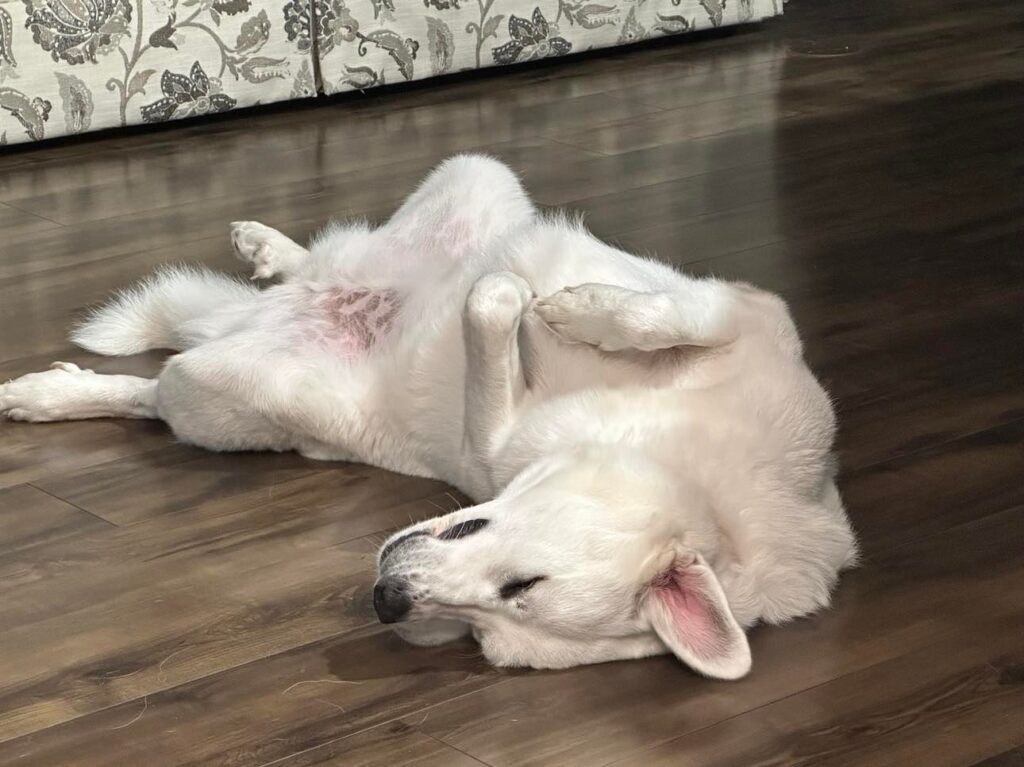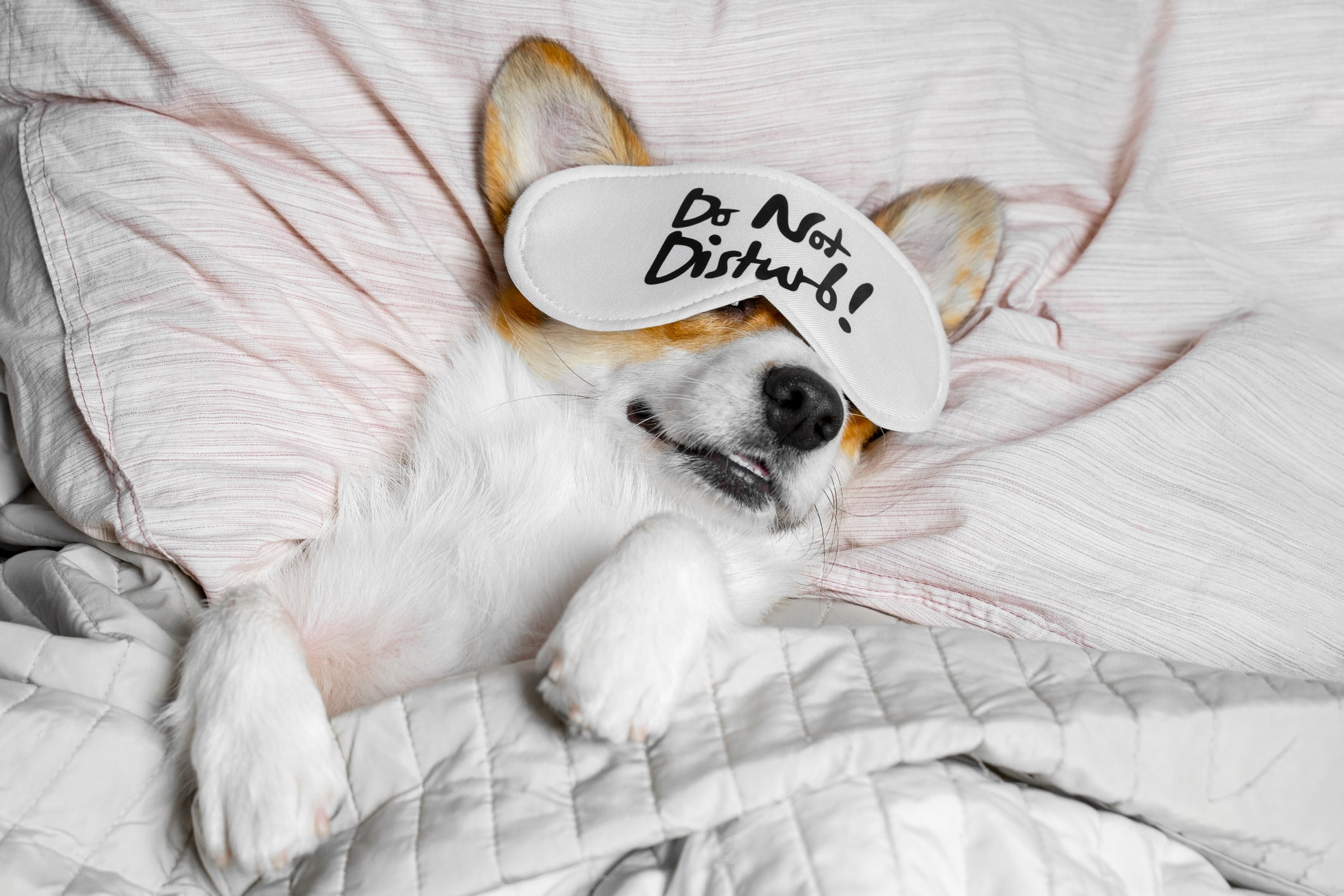Earlier today, while working in my office, I was interrupted by a distinct whimper from Harley. Glancing over, I noticed he was deep in sleep, dreaming. It made me wonder: Do dogs dream? Curious, I decided to research the topic. Here is what I discovered.
Do Dogs Dream? Decoding Your Canine’s Sleep Behavior
When your dog is nestled in their bed, have you ever noticed those gentle twitches or faint paw movements? You have even heard soft, muffled barks. These behaviors spark a common question among pet owners: “Is my dog having a dream?” Delving into the studies of animal behaviorists and scientific research, there’s compelling evidence that suggests our canine companions indeed experience dreams.
How Dogs’ Dreams Work: A Glimpse into Canine Brain Activity
Just like humans, dogs enter various stages of sleep, including the Rapid Eye Movement (REM) phase, which is closely associated with dreaming. By examining the brain activity of sleeping dogs, scientists have uncovered fascinating insights into the canine dream world. In this section, we will explore the mechanics of a dog’s sleep cycle and how it relates to their dream patterns.
The Mechanics of Canine Dreams
When dogs sleep, their brain activity undergoes various stages, much like humans. One of these stages, the Rapid Eye Movement (REM) phase, is where most dreaming occurs. Here is a breakdown of how this works:
- REM Sleep in Dogs: During the REM phase, a dog’s brain activity increases, resembling the awake state. This stage is when they experience dreams. You might notice quick eye movements, twitching paws, or even soft barks.
- Non-REM Sleep: Before entering the REM phase, dogs go through a deep, non-REM sleep. It is a restorative phase, essential for muscle repair and growth. Dreaming is less frequent at this stage.
- Frequency of Dreams: Puppies and senior dogs tend to dream more often than middle-aged dogs. The frequency of dreams also varies with the dog’s size. Smaller breeds might dream more frequently than larger ones.
- Duration of Dreams: While it is challenging to pinpoint the exact duration of a dog’s dream, it’s believed that smaller breeds have shorter, more frequent dreams, while larger breeds might have longer but less frequent dreams.
Understanding these mechanics gives us insight into the importance of uninterrupted sleep for dogs. It’s not just about rest; it’s also about processing, learning, and even emotional well-being.
What Do Dogs Dream About?
While we cannot definitively know the exact content of a dog’s dream, researchers and animal behaviorists have made educated guesses based on observed behaviors and understanding of a dog’s daily life. Here is what the science suggests:
- Daily Experiences: Like humans, dogs likely dream about their daily activities. A game of fetch, a walk in the park, or an encounter with a neighborhood cat might all feature in a dog’s dream.
- Instinctual Behaviors: Dogs might dream about activities related to their primal instincts, such as chasing prey or searching for food. This is especially true for breeds with strong hunting or herding backgrounds.
- Emotional Processing: Dreams can be a way for dogs to process emotions or events that were significant or confusing to them. For instance, a rescue dog might have dreams related to past traumas as they work through their experiences.
- Learning and Memory Consolidation: Sleep plays a crucial role in memory consolidation. Dogs might dream about new tricks they have learned or new environments they have explored, helping them solidify these experiences in their memory.
Understanding the potential content of our dogs’ dreams can deepen the bond we share with them, reminding us of the rich inner lives they lead even when they are asleep.
Ensuring a Restful Sleep for Your Dog and Recognizing Sleep Disturbances
Ensuring that your dog has a comfortable and uninterrupted sleep is crucial for their overall well-being. Here are tips and things to watch out for:
- Creating a Comfortable Sleeping Environment: Just like humans, dogs prefer a quiet, dark, and comfortable place to sleep. Consider investing in a cozy dog bed and placing it in a quiet corner of your home.
- Establishing a Routine: Dogs thrive on routine. Having a consistent bedtime can help regulate their sleep patterns and ensure they get enough rest.
- Diet and Exercise: A balanced diet and regular exercise can promote better sleep. Ensure your dog gets adequate physical activity during the day, especially before bedtime.
- Recognizing Sleep Disturbances: If your dog frequently wakes up, whines, or seems restless during sleep, it might be a sign of a health issue or sleep disturbance. It is essential to consult with a veterinarian in such cases.
- Responding to Nightmares: Occasionally, dogs might have bad dreams, causing them to whimper or twitch more than usual. Gently comforting them without fully waking them can help them transition out of the distressing dream.
- Avoiding Sleep Interruptions: If you notice your dog deeply dreaming (twitching, soft barking), it is best not to wake them abruptly. Like humans, dogs can feel disoriented if awakened suddenly from a deep sleep.
By understanding and addressing your dog’s sleep needs and behaviors, you can ensure they have a restful night, which contributes to their overall health and happiness.
The Connection Between Sleep and Overall Health in Dogs
Sleep isn’t just a time for dreams; it’s a crucial period for dogs to recover, rejuvenate, and process their experiences. In this section, we will delve into:
- The Role of Sleep in Physical Health:
Sleep is vital for a dog’s physical health. During this rest period, their body goes into repair mode. Muscles that have been exerted during the day get a chance to heal. The body also produces essential hormones during sleep, which are crucial for growth and metabolism. For active dogs, especially, a good sleep ensures they have the energy and vitality for the next day’s adventures.
- Mental Well-being and Sleep:
Sleep is not just about physical rejuvenation; it’s also about mental refreshment. When dogs sleep, they process the day’s events, leading to memory consolidation. This is especially important for training and learning new commands. Moreover, a well-rested dog is more alert, responsive, and exhibits a more balanced temperament.
- The Impact of Age on Sleep:
Just like human babies, puppies sleep a lot. It is during this time that they grow and develop. As dogs age, their sleep patterns might change. Senior dogs might sleep more due to reduced energy levels or health issues. Recognizing these shifts in sleep patterns can help owners adjust routines and ensure their pets get the rest they need.
- Potential Health Issues from Sleep Deprivation:
Consistent lack of sleep can have detrimental effects on a dog’s health. They might become irritable, less responsive to commands, or show signs of anxiety. Physically, sleep deprivation can weaken their immune system, making them more susceptible to illnesses. Over time, chronic sleep deprivation can even reduce their overall lifespan.
- When to Consult a Veterinarian:
It is essential to monitor any sudden changes in a dog’s sleep pattern. If they are struggling to sleep, waking up frequently, or seem excessively tired during the day, it could be a sign of an underlying health issue. In such cases, a consultation with a veterinarian is crucial to rule out potential health concerns.
By understanding and prioritizing sleep, dog owners can ensure their pets lead a balanced, healthy, and happy life.
Navigating Sleep Disturbances in Dogs:
Dogs, like their human counterparts, can experience a range of sleep disturbances that can impact their overall health and daily behavior. Observing your dog restlessly tossing and turning, or hearing them whimper or bark in their sleep, can be concerning for any pet owner. These disruptions can be indicative of various issues:
- Restlessness: Just like humans, dogs can have nights where they simply cannot find a comfortable position. This could be due to minor discomforts, but if persistent, it might indicate joint pain or other health issues.
- REM Sleep Behavior Disorder: During the REM (Rapid Eye Movement) stage of sleep, dogs dream. Most dogs are paralyzed during this stage and will not act out their dreams. However, those with REM Sleep Behavior Disorder lack this paralysis. This can lead them to physically act out their dreams, which can sometimes be aggressive or dangerous.
- Insomnia: Believe it or not, dogs can suffer from insomnia. Factors like age, health conditions, or environmental changes can lead to sleepless nights. Symptoms include difficulty falling asleep, frequent awakenings, and early morning wakeups.
- Nightmares: Dogs can have bad dreams, just like humans. If your dog frequently wakes up frightened or seems anxious after waking, they might be experiencing nightmares.
Understanding these disturbances is the first step. If you notice consistent patterns or increasing sleep disruptions, it’s essential to consult with a veterinarian. They can provide insights into potential underlying causes and recommend treatments or interventions to ensure your furry friend gets the quality sleep they need.
Understanding Sleep Postures in Dogs:

The way a dog sleeps can reveal a great deal about their mood, health, and even their personality. From curled up in a ball to sprawled out on their back, each position can offer insights into how your dog is feeling.
- On Their Side: This is one of the most common positions, especially among more relaxed and comfortable dogs. If your dog sleeps on their side, it often means they are feeling very content and secure in their environment.
- Curled Up: Dogs that sleep curled up in a ball or with their tail wrapped around their body are trying to protect their vital organs. This position can also help them conserve body heat. It is a common position in the wild, offering protection and warmth.
- Upside Down: Dogs that sleep on their backs with their legs in the air are feeling particularly relaxed and confident. This position exposes their belly, which is a vulnerable area, so a dog will only assume this position if they feel safe.
When we brought Sasha, our Akbash/Great Pyrenees mix, home for the first time, her upside-down sleeping habits took us by surprise. This was quite different from our Goldens, who usually slept on their sides or curled up. But we quickly understood that this was simply Sasha’s unique way of finding comfort and security in her new environment. - Superman Pose: Some dogs sleep with their legs stretched out in front and behind them, resembling a flying Superman. This position is common in puppies and more playful dogs. It allows them to jump up and get into action quickly, should they need to.
Observing your dog’s sleeping habits can provide valuable insights into their well-being. If there is a sudden change in their preferred sleeping position or if they seem restless, it might be worth consulting with a veterinarian to ensure there are no underlying health issues.
Conclusion:
Dogs, like humans, have their unique personalities, habits, and ways of expressing comfort and contentment. Their sleeping positions can serve as a window into their well-being and emotions. By understanding and observing these sleep postures, dog owners can gain a deeper connection with their furry companions, ensuring they provide the best care and environment for them. Always remember, while these sleeping positions can offer insights, the most important thing is to ensure your dog feels safe, loved, and comfortable in their resting space.
Q & A
Q: Do Dogs Dream?
A: Yes, it has been scientifically proven that dogs dream. Research on dogs’ brain activity and sleep patterns, including REM (Rapid Eye Movement) sleep, suggests that they experience dreams similar to humans.
Q: What do dogs actually dream about?
A: Dogs likely dream about their daily activities such as playing fetch, walking in the park, or interacting with other animals. They might also dream about instinctual behaviors like chasing prey or searching for food. Emotional processing and memories of significant or confusing events can also be part of their dream content.
Q: What do dogs dream about when they whimper?
A: When dogs whimper in their sleep, it could indicate they are having an emotional or distressing dream. This might relate to past experiences, daily events, or even potential anxieties. However, it’s important to note that not every whimper signifies a negative dream; it could also be a mere vocal expression during REM sleep.
Q: What do dogs dream about when they twitch?
A: Twitching during sleep often occurs during the REM phase, where most dreaming happens. The twitches can be a physical manifestation of the dream’s content. For instance, a dog might be dreaming of running or playing, leading to twitching paws. It’s a natural part of their sleep cycle and is akin to humans moving in their sleep.
Q: What are the typical canine sleep patterns, and do these patterns include dreaming?
A: Canine sleep patterns involve various stages, including deep sleep and REM (Rapid Eye Movement) sleep, during which dogs are believed to experience dreaming.
Q: What is dog REM sleep, and is it the phase during which they dream?
A: Dog REM sleep refers to the Rapid Eye Movement sleep stage in dogs. During this phase, dogs often exhibit signs such as twitching, paw movements, and sometimes vocalizations, indicating that they are indeed experiencing dreams.
Q: Do dogs have dreams and nightmares?
A: Yes, dogs do have dreams and, occasionally, nightmares. Just like humans, they go through the REM sleep phase, which is closely associated with dreaming. While the exact content of their dreams remains a mystery, behaviors like twitching, soft barking, or whimpering can indicate they are in a dream state. If a dog seems particularly distressed during sleep, it might be experiencing a nightmare.
Q: How do canine sleep cycles compare to human sleep cycles?
A: Just like humans, dogs go through different stages of sleep, including the REM (Rapid Eye Movement) phase where dreaming occurs. However, the frequency and duration of these cycles can vary based on the dog’s age and size.
Q: Why does my dog bark or growl in their sleep?
A: Dogs often vocalize during the REM phase of sleep, which is when dreaming happens. Barking or growling can reflect what they are dreaming about, whether it’s chasing something, playing, or reacting to a past experience.
Q: Is it normal for puppies to twitch a lot in their sleep?
A: Yes, it is common for puppies to twitch during sleep, especially during the REM phase. Puppies tend to dream more frequently than adult dogs, leading to more noticeable physical reactions like twitching.
Q: Should I wake my dog if they seem to be having a nightmare?
A: It is best to let dogs sleep through their dreams, even if they seem distressed. However, if a dog appears extremely agitated, you can gently comfort them without fully waking them up. Abruptly waking a dog from a deep sleep can cause confusion or disorientation.
Q: How can I ensure my dog has a comfortable sleep environment?
A: Providing a quiet, dark, and cozy space for your dog can promote better sleep. Investing in a comfortable dog bed and establishing a consistent bedtime routine can also help regulate their sleep patterns.




